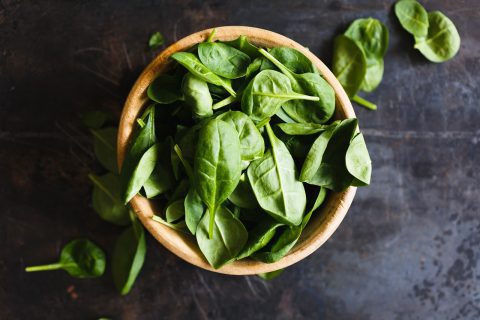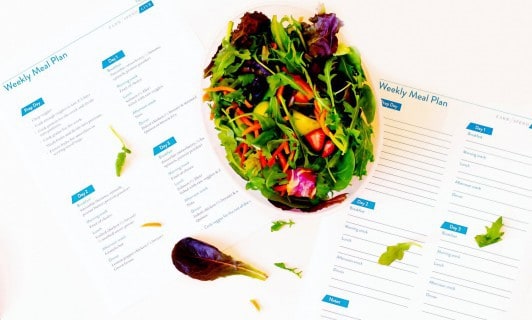What Does It Really Mean to Eat Clean?

People always talk about how dating is just the hardest thing ever, but I disagree. Following a diet is the hardest thing. I mean, where do you even start? How do you choose a clean eating plan, and how do you know if it’s going to actually do any good? Let’s be honest here, trying to form a healthy relationship with food and your body is 10 times as exhausting as trying to find love. If I’ve learned anything in my lifelong attempt to find a happy medium between skinniness and enjoying food, it’s that diets don’t work.
Cutting carbs, counting calories, having cheat days, and all of that doesn’t work for me. The only “diet” that’s ever clicked with me and fit in with my lifestyle is clean eating. It’s not a diet, it’s a way of eating for life, and it allows me to indulge when I want to without guilt.
Eating clean is simple, too. I don’t have to monitor anything other than the quality of food going into my mouth. I don’t know of anything more manageable than that. Not to mention, I love the way I feel when I’m eating clean, and that’s more than enough to keep me on track.
What is Clean Eating?
Clean eating is a method of eating that focuses on “real” foods. When eating clean, you eat foods as close to their original source as possible, so there’s very little unnatural stuff going into your body. You don’t have to count calories or carbs when eating clean. Instead, you make an effort to eat more fruits, vegetables, healthy proteins, whole grains, and healthy fats than anything else. This often means you choose organic food when shopping, but it’s not a strict requirement.
However, eating clean doesn’t mean you can ignore proper portions. Foods still have calories even if you don’t count them. You can’t gorge yourself on healthy whole foods and expect to develop a six-pack. The good thing though is that the servings for most whole foods are far more filling than a serving of potato chips.
The Restrictions
Junk food is not welcome in a clean eating plan. That being said, clean eating is not meant to be a restrictive diet. It’s not meant to be a “diet” at all. It’s intended to be a lifestyle choice.
Foods that contain additives, have been processed, modified, and altered aren’t truly healthy foods. Added hormones, preservatives, dyes, and flavors change the nutritional value of food. Cookies, potato chips, premade meals, lunch meats, white bread, pastas, most dairy, desserts, and most of the foods stored in the middle shelves of the grocery store don’t fall in the clean food category. If you’re going to eat clean, you have to give junk food, fast food, and sugary treats up.
The Food Labels
If you’re buying something that’s not a raw meat or veggie, check the food label. You want to buy foods with very few ingredients, and you want them to all be pronounceable. If an item has a long list of ingredients and you don’t recognize most of them, then you should leave it at the store and choose something else. Food labels are confusing to read, so don’t try to decipher the mumbo jumbo. Just look for ingredients you know and food that’s made in a straightforward way.
How to Start Eating Clean
The key to success with clean eating is properly stocking your fridge and pantry with healthy, whole foods and not purchasing any processed, modified, or handled foods. When you have a kitchen bursting with plenty of fruits, vegetables, grains, and proteins to keep you satisfied and energized, you’ll be less likely to order a pizza or run out for a Snickers bar. When you have healthy, nutritious food in your house, you’ll eat healthy, nutritious food.
Eating out can be a struggle when you’re trying to eat clean, but with the right mindset and a plan, it can be done. It’s best to peruse the salad, soup, and sandwich sections. These are typically your best bet at any restaurant. You can still enjoy the main entrees though. As long as you keep the mindset that you’re looking for vegetables, whole grains, and protein, you’ll be able to find something on the menu that works. Sadly, fried foods, most pastas, desserts, and any dishes containing dairy are going to be off limits.
The best way to stay on a clean eating meal plan is to prepare meals ahead of time and pack food to take with you each day. Taking a clean, healthy lunch to work will keep you from eating out and being tempted with unhealthy foods, and you’ll ultimately save yourself some money.
It’s also helpful to have healthy snacks with you. Bags of nuts, fruit, organic granola bars, and even protein powder are all great options to keep in your bag as you go through the day. These healthy snacks serve as a security net against the need for some food at a moment’s notice. Without them, you’re more likely to grab the first thing you can find, and that thing will likely be something unhealthy.
The Health Benefits
There are so many healthy benefits to a clean diet. In my personal experience, following a clean diet (for me this also means no dairy of any sort) has cleared up my skin, given me more energy in the gym, completely eliminated bloating, and left my hair softer. Vegetables and fruits come with a wide range of vitamins and nutrients to benefit your body. Consuming more fresh fruits and veggies provides your body with the good stuff that it needs to operate its various functions at a high level.
Some of the possible benefits include better sleep quality, fewer illnesses, lower body fat, and more regular digestion. It’s also beneficial to your blood sugar, blood pressure, and cardiovascular health.
Follow Terra on Instagram: @terrabrown3
Last modified on February 21st, 2017






Show Comments +